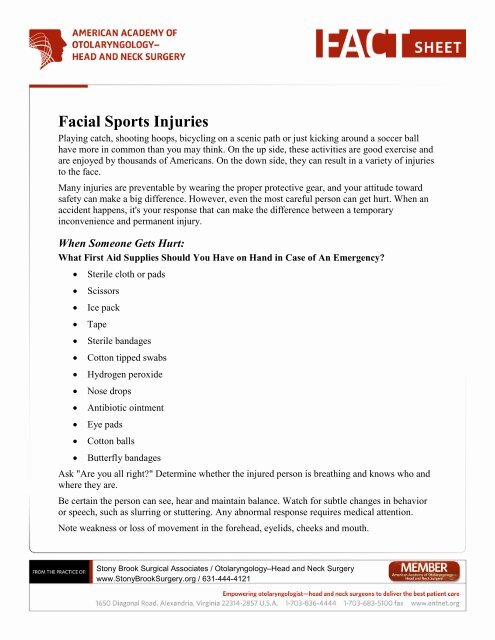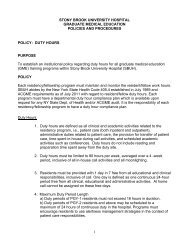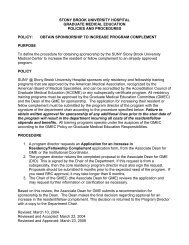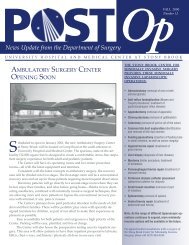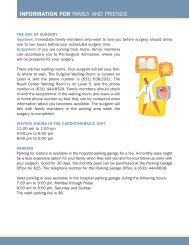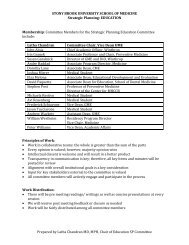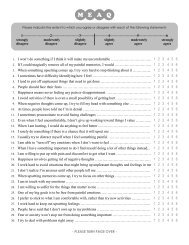Facial Sports Injuries - Stony Brook University School of Medicine
Facial Sports Injuries - Stony Brook University School of Medicine
Facial Sports Injuries - Stony Brook University School of Medicine
Create successful ePaper yourself
Turn your PDF publications into a flip-book with our unique Google optimized e-Paper software.
<strong>Facial</strong> <strong>Sports</strong> <strong>Injuries</strong><br />
Playing catch, shooting hoops, bicycling on a scenic path or just kicking around a soccer ball<br />
have more in common than you may think. On the up side, these activities are good exercise and<br />
are enjoyed by thousands <strong>of</strong> Americans. On the down side, they can result in a variety <strong>of</strong> injuries<br />
to the face.<br />
Many injuries are preventable by wearing the proper protective gear, and your attitude toward<br />
safety can make a big difference. However, even the most careful person can get hurt. When an<br />
accident happens, it's your response that can make the difference between a temporary<br />
inconvenience and permanent injury.<br />
When Someone Gets Hurt:<br />
What First Aid Supplies Should You Have on Hand in Case <strong>of</strong> An Emergency?<br />
• Sterile cloth or pads<br />
• Scissors<br />
• Ice pack<br />
• Tape<br />
• Sterile bandages<br />
• Cotton tipped swabs<br />
• Hydrogen peroxide<br />
• Nose drops<br />
• Antibiotic ointment<br />
• Eye pads<br />
• Cotton balls<br />
• Butterfly bandages<br />
Ask "Are you all right?" Determine whether the injured person is breathing and knows who and<br />
where they are.<br />
Be certain the person can see, hear and maintain balance. Watch for subtle changes in behavior<br />
or speech, such as slurring or stuttering. Any abnormal response requires medical attention.<br />
Note weakness or loss <strong>of</strong> movement in the forehead, eyelids, cheeks and mouth.<br />
<strong>Stony</strong> <strong>Brook</strong> Surgical Associates / Otolaryngology–Head and Neck Surgery<br />
www.<strong>Stony</strong><strong>Brook</strong>Surgery.org / 631-444-4121
Look at the eyes to make sure they move in the same direction and that both pupils are the same<br />
size.<br />
If any doubts exist, seek immediate medical attention.<br />
When Medical Attention Is Required, What Can You Do?<br />
• Call for medical assistance (911).<br />
• Do not move the victim, or remove helmets or protective gear.<br />
• Do not give food, drink or medication until the extent <strong>of</strong> the injury has been determined.<br />
• Remember HIV...be very careful around body fluids. In an emergency protect your hands<br />
with plastic bags.<br />
• Apply pressure to bleeding wounds with a clean cloth or pad, unless the eye or eyelid is<br />
affected or a loose bone can be felt in a head injury. In these cases, do not apply pressure<br />
but gently cover the wound with a clean cloth.<br />
• Apply ice or a cold pack to areas that have suffered a blow (such as a bump on the head)<br />
to help control swelling and pain.<br />
• Remember to advise your doctor if the patient has HIV or hepatitis.<br />
<strong>Facial</strong> Fractures<br />
<strong>Sports</strong> injuries can cause potentially serious broken bones or fractures <strong>of</strong> the face. Common<br />
symptoms <strong>of</strong> facial fractures include:<br />
• Swelling and bruising, such as a black eye<br />
• Pain or numbness in the face, cheeks or lips<br />
• Double or blurred vision<br />
• Nosebleeds<br />
• Changes in teeth structure or ability to close mouth properly<br />
It is important to pay attention to swelling because it may be masking a more serious injury.<br />
Applying ice packs and keeping the head elevated may reduce early swelling.<br />
If any <strong>of</strong> these symptoms occur, be sure to visit the emergency room or the <strong>of</strong>fice <strong>of</strong> a facial<br />
plastic surgeon (such as an otolaryngologist-head and neck surgeon) where x-rays may be taken<br />
to determine if there is a fracture.<br />
Upper Face<br />
When you are hit in the upper face (by a ball for example) it can fracture the delicate bones<br />
around the sinuses, eye sockets, bridge <strong>of</strong> the nose or cheek bones. A direct blow to the eye may<br />
<strong>Stony</strong> <strong>Brook</strong> Surgical Associates / Otolaryngology–Head and Neck Surgery<br />
www.<strong>Stony</strong><strong>Brook</strong>Surgery.org / 631-444-4121
cause a fracture, as well as blurred or double vision. All eye injuries should be examined by an<br />
eye specialist (ophthalmologist).<br />
Lower Face<br />
When your jaw or lower face is injured, it may change the way your teeth fit together. To restore<br />
a normal bite, surgeries <strong>of</strong>ten can be performed from inside the mouth to prevent visible scarring<br />
<strong>of</strong> the face; and broken jaws <strong>of</strong>ten can be repaired without being wired shut for long periods.<br />
Your doctor will explain your treatment options and the latest treatment techniques.<br />
S<strong>of</strong>t Tissue <strong>Injuries</strong><br />
Bruises cuts and scrapes <strong>of</strong>ten result from high speed or contact sports, such as boxing, football,<br />
soccer, ice hockey, bicycling skiing, and snowmobiling. Most can be treated at home, but some<br />
require medical attention.<br />
You should get immediate medical care when you have:<br />
• Deep skin cuts<br />
• Obvious deformity or fracture<br />
• Loss <strong>of</strong> facial movement<br />
• Persistent bleeding<br />
• Change in vision<br />
• Problems breathing and/or swallowing<br />
• Alterations in consciousness or facial movement<br />
Bruises<br />
Also called contusions, bruises result from bleeding underneath the skin. Applying pressure,<br />
elevating the bruised area above the heart and using an ice pack for the first 24 to 48 hours<br />
minimizes discoloration and swelling. After two days, a heat pack or hot water bottle may help<br />
more. Most <strong>of</strong> the swelling and bruising should disappear in one to two weeks.<br />
Cuts and Scrapes<br />
The external bleeding that results from cuts and scrapes can be stopped by immediately applying<br />
pressure with gauze or a clean cloth. When the bleeding is uncontrollable, you should go to the<br />
emergency room.<br />
Scrapes should be washed with soap and water to remove any foreign material that could cause<br />
infection and discoloration <strong>of</strong> the skin. Scrapes or abrasions can be treated at home by cleaning<br />
with 3% hydrogen peroxide and covering with an antibiotic ointment or cream until the skin is<br />
healed. Cuts or lacerations, unless very small, should be examined by a physician. Stitches may<br />
be necessary, and deeper cuts may have serious effects. Following stitches, cuts should be kept<br />
<strong>Stony</strong> <strong>Brook</strong> Surgical Associates / Otolaryngology–Head and Neck Surgery<br />
www.<strong>Stony</strong><strong>Brook</strong>Surgery.org / 631-444-4121
clean and free <strong>of</strong> scabs with hydrogen peroxide and antibiotic ointment. Bandages may be<br />
needed to protect the area from pressure or irritation from clothes. You may experience<br />
numbness around the cut for several months. Healing will continue for 6 to 12 months. The<br />
application <strong>of</strong> sunscreen is important during the healing process to prevent pigment<br />
changes. Scars that look too obvious after this time should be seen by a facial plastic surgeon.<br />
Nasal <strong>Injuries</strong><br />
The nose is one <strong>of</strong> the most injured areas on the face. Early treatment <strong>of</strong> a nose injury consists <strong>of</strong><br />
applying a cold compress and keeping the head higher than the rest <strong>of</strong> the body. You should seek<br />
medical attention in the case <strong>of</strong>:<br />
• Breathing difficulties<br />
• Deformity <strong>of</strong> the nose<br />
• Persistent bleeding<br />
• Cuts<br />
Bleeding<br />
Nosebleeds are common and usually short-lived. Often they can be controlled by squeezing the<br />
nose with constant pressure for 5 to 10 minutes. If bleeding persists, seek medical attention.<br />
Bleeding also can occur underneath the surface <strong>of</strong> the nose. An otolaryngologist/facial plastic<br />
surgeon will examine the nose to determine if there is a clot or collection <strong>of</strong> blood beneath the<br />
mucus membrane <strong>of</strong> the septum (a septal hematoma) or any fracture. Hematomas should be<br />
drained so the pressure does not cause nose damage or infection.<br />
Fractures<br />
Some otolaryngologist-head and neck specialists set fractured bones right away before swelling<br />
develops, while others prefer to wait until the swelling is gone. These fractures can be repaired<br />
under local or general anesthesia, even weeks later.<br />
Ultimately, treatment decisions will be made to restore proper function <strong>of</strong> the nasal air passages<br />
and normal appearance and structural support <strong>of</strong> the nose. Swelling and bruising <strong>of</strong> the nose may<br />
last for 10 days or more.<br />
Neck <strong>Injuries</strong><br />
Whether seemingly minor or severe, all neck injuries should be thoroughly evaluated by an<br />
otolaryngologist -- head and neck surgeon. <strong>Injuries</strong> may involve specific structures within the<br />
neck, such as the larynx (voicebox), esophagus (food passage), or major blood vessels and<br />
nerves.<br />
<strong>Stony</strong> <strong>Brook</strong> Surgical Associates / Otolaryngology–Head and Neck Surgery<br />
www.<strong>Stony</strong><strong>Brook</strong>Surgery.org / 631-444-4121
Throat <strong>Injuries</strong><br />
The larynx is a complex organ consisting <strong>of</strong> cartilage, nerves and muscles with a mucous<br />
membrane lining all encased in a protective tissue (cartilage) framework.<br />
The cartilages can be fractured or dislocated and may cause severe swelling, which can result in<br />
airway obstruction. Hoarseness or difficulty breathing after a blow to the neck are warning signs<br />
<strong>of</strong> a serious injury and the injured person should receive immediate medical attention.<br />
Prevention Of <strong>Facial</strong> <strong>Sports</strong> <strong>Injuries</strong><br />
The best way to treat facial sports injuries is to prevent them. To insure a safe athletic<br />
environment, the following guidelines are suggested:<br />
• Be sure the playing areas are large enough that players will not run into walls or other<br />
obstructions.<br />
• Cover unremoveable goal posts and other structures with thick, protective padding.<br />
• Carefully check equipment to be sure it is functioning properly.<br />
• Require protective equipment - such as helmets and padding for football, bicycling and<br />
rollerblading; face masks, head and mouth guards for baseball; ear protectors for<br />
wrestlers; and eyeglass guards or goggles for racquetball and snowmobiling are just a<br />
few.<br />
• Prepare athletes with warm-up exercises before engaging in intense team activity.<br />
• In the case <strong>of</strong> sports involving fast-moving vehicles, for example, snowmobiles or dirt<br />
bikes - check the path <strong>of</strong> travel, making sure there are no obstructing fences, wires or<br />
other obstacles.<br />
• Enlist adequate adult supervision for all children's competitive sports.<br />
<strong>Stony</strong> <strong>Brook</strong> Surgical Associates / Otolaryngology–Head and Neck Surgery<br />
www.<strong>Stony</strong><strong>Brook</strong>Surgery.org / 631-444-4121


